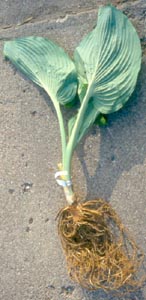 The underground portion of the
hosta plant is called the crown. It is the point of
growth for hostas and all leaves and flower stems
originate from buds on the crown. The roots extend
out of the bottom of the crown.
The underground portion of the
hosta plant is called the crown. It is the point of
growth for hostas and all leaves and flower stems
originate from buds on the crown. The roots extend
out of the bottom of the crown.
Larger hostas have a thickened crown that may become
quite large as the plant matures. To obtain a
division capable of developing into a new plant,
there needs to be enough so that a piece may be
removed that contains some of the crown, some roots
and either a leaf (during the growing season) or
buds (during the dormant part of the year). Many of
the larger hostas tend to multiply slowly and may
not produce a lot of buds each year.
Smaller hostas may have a thinner, intertwined root
system. Often these start with the original division
and then grow by
rhizomes
out to the sides in all
directions. Again, as long as you can separate them
so that you end up with a piece of crown, stems or
buds and roots, you have a division. Cultivars such
as ‘Golden Tiara’ multiply quickly and may be
divided almost yearly if you need more plants to
spread around your landscape.
Hostas may generally be divided “when the shovel is
sharp” but this depends on post-division care. If
you keep them adequately watered, they will survive
division most any time. However, the cool days of
the spring and the fall are the best for assured
success.
Be sure to use sharp tool when you make divisions.
Ragged cuts tend to stay open longer and may lead to
rot problems. Although you will often hear the
advice to dip the cut crowns in a
fungicide, there
are millions of hosta divisions made each year
without this step. It would be more important if you
have an existing problem with root rot in your
garden. Generally, it is not needed.



